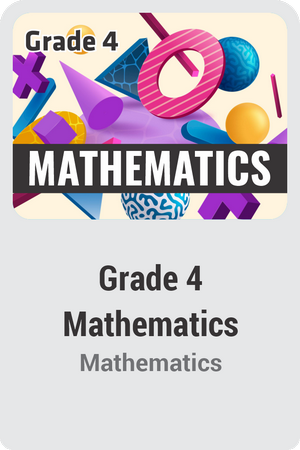
Course Overview:
In Math Grade 4, students will multiply and divide multi-digit whole numbers using different strategies and a standard algorithm. The course provides the opportunity for students to see the relationship between fractions and decimals and introduces addition and subtraction of each. Using a protractor to draw and measure angles is another focus of the course. Other engaging activities include learning about measurement and using median, mode, and range as ways to interpret data.
Prerequisites:
Grade 3 (Recommended)
Major Topics and Concepts
Segment One
- using place value patterns
- reading and writing whole numbers in different ways
- plotting, ordering, and comparing multi-digit whole numbers
- rounding multi-digit whole numbers
- adding and subtracting multi-digit whole numbers
- factors and multiples
- determining prime and composite numbers
- multiplying multi-digit numbers using strategies and a standard algorithm
- dividing by a one-digit number
- using number patterns
- understanding equations and variables
- understanding perimeter and area relationships
- finding median, mode, and range of whole numbers
- stem-and-leaf plots of whole numbers
- line plots with whole numbers
Segment Two
- understanding mixed numbers
- finding equivalent fractions and mixed numbers using different strategies
- adding fractions and mixed numbers
- subtracting fractions and mixed numbers
- multiplying a fraction by a whole number
- understanding fraction and decimal relationships
- working with decimals to the hundredths place
- finding median, mode, and range of fractions and decimals
- stem-and-leaf plots with fractions and decimals
- line plots with fractions and decimals
- measuring units of measure in the metric and customary system
- converting units of measure in the metric and customary system
- measuring and drawing angles
Required Materials:
- printer
- cell phone or scanner
- headset or earbuds
- notebook
- pens
- pencils
- erasers
- scissors
- coloring materials (markers, crayons, colored pencils)
- glue
- tape
- stapler
- ruler
- printer paper
- lined paper
- colored paper
- protractor
- general household objects for activities
Syllabus:
Module 01: Place Value Understanding
- 01.00 Place Value Understanding: Pretest
- 01.01 Place Value Patterns
- 01.02 Reading and Writing Whole Numbers
- 01.03 Comparing and Ordering Whole Numbers
- 01.04 Rounding Whole Numbers
- 01.05 Adding Multi-Digit Whole Numbers
- 01.06 Subtracting Multi-Digit Whole Numbers
Module 02: Multiples and Factors
- 02.00 Multiples and Factors: Pretest
- 02.01 Multiplication Facts with Models
- 02.02 Multiplication Facts with Mental Math
- 02.03 Multiplying by 10s, 100s, and 1,000s:
- 02.04 Factor Pairs
- 02.05 Multiples and Factors: Review
Module 03: One-Digit Multiplication
- 03.00 One-Digit Multiplication: Pretest
- 03.01 Estimates with a One-Digit Factor
- 03.02 Area Models with a One-Digit Factor
- 03.03 Partial Products with a One-Digit Factor
- 03.04 A Standard Algorithm with a One-Digit Factor
Module 04: Multi-Digit Multiplication
- 04.00 Multi-Digit Multiplication: Pretest
- 04.01 Estimates with Multi-Digit Factors
- 04.02 Area Models with Multi-Digit Factors
- 04.03 Partial Products with Multi-Digit Factors
- 04.04 A Standard Algorithm with Multi-Digit Factors
- 04.05 Multi-Digit Multiplication: Review
Module 05: Dividing by a One-Digit Divisor
- 05.00 Dividing by a One-Digit Divisor: Pretest
- 05.01 Getting to Know Division
- 05.02 Estimating Quotients
- 05.03 Dividing with Area Models
- 05.04 Partial Quotients
- 05.05 Long Division
- 05.06 Problem Solving with Division
Module 06: Algebraic Thinking
- 06.00 Algebraic Thinking: Pretest
- 06.01 Prime or Composite
- 06.02 Number Patterns
- 06.03 Understanding Equations
- 06.04 Writing Equations
- 06.05 Perimeter and Area
- 06.06 Patterns with Perimeter and Area
- 06.07 Algebraic Thinking: Review
Module 07: Data with Whole Numbers
- 07.00 Data with Whole Numbers: Pretest
- 07.01 Median, Mode, and Range
- 07.02 Line Plots
- 07.03 Stem-and-Leaf Plots
Module 08: Equivalent Fractions and Mixed Numbers
- 08.00 Equivalent Fractions and Mixed Numbers: Pretest
- 08.01 Understanding Mixed Numbers
- 08.02 Equivalent Fractions with Models
- 08.03 Equivalent Fractions with Number Lines
- 08.04 Equivalent Fractions with Equations
- 08.05 Using Equivalent Fractions to Compare and Order
- 08.06 Using Benchmark Fractions to Compare and Order
- 08.07 Equivalent Fractions and Mixed Numbers: Review
Module 09: Working with Fractions and Mixed Numbers
- 09.00 Working with Fractions and Mixed Numbers: Pretest
- 09.01 Decomposing Fractions and Mixed Numbers
- 09.02 Adding and Subtracting Fractions with Models
- 09.03 Adding and Subtracting Fractions with a Number Line
- 09.04 Adding Fractions with A Standard Algorithm
- 09.05 Subtracting Fractions with A Standard Algorithm
- 09.06 Exploring Fraction Multiplication
Module 10: Decimal Numbers
- 10.00 Decimal Numbers: Pretest
- 10.01 Decimals Less Than 1
- 10.02 Decimals Greater Than 1
- 10.03 Comparing and Ordering Decimals
- 10.04 Adding and Subtracting Decimals
- 10.05 Solving Money Problems with Decimals
- 10.06 Decimal Numbers: Review
Module 11: Data with Fractions and Decimals
- 11.00 Data with Fractions and Decimals: Pretest
- 11.01 Interpreting Fraction and Decimal Data
- 11.02 Plotting with Fractions
- 11.03 Plotting with Decimals
Module 12: Measurement with Metric Units
- 12.00 Measurement with Metric Units: Pretest
- 12.01 Measuring Metric Lengths
- 12.02 Converting Metric Lengths
- 12.03 Metric Units of Volume
- 12.04 Metric Units of Mass
- 12.05 Measuring Temperature
- 12.06 Measurement with Metric Units: Review
Module 13: Measurement with Customary Units
- 13.00: Measurement with Customary Units: Pretest
- 13.01 Measuring Customary Lengths
- 13.02 Converting Customary Lengths
- 13.03 Customary Units of Volume
- 13.04 Customary Units of Weight
- 13.05 Converting Units of Time
Module 14: Measuring Angles
- 14.00: Measuring Angles: Pretest
- 14.01 Types of Angles
- 14.02 Measuring with a Protractor
- 14.03 Benchmark and Additive Angles
- 14.04 Drawing with a Protractor
- 14.05 Measuring Angles: Review


